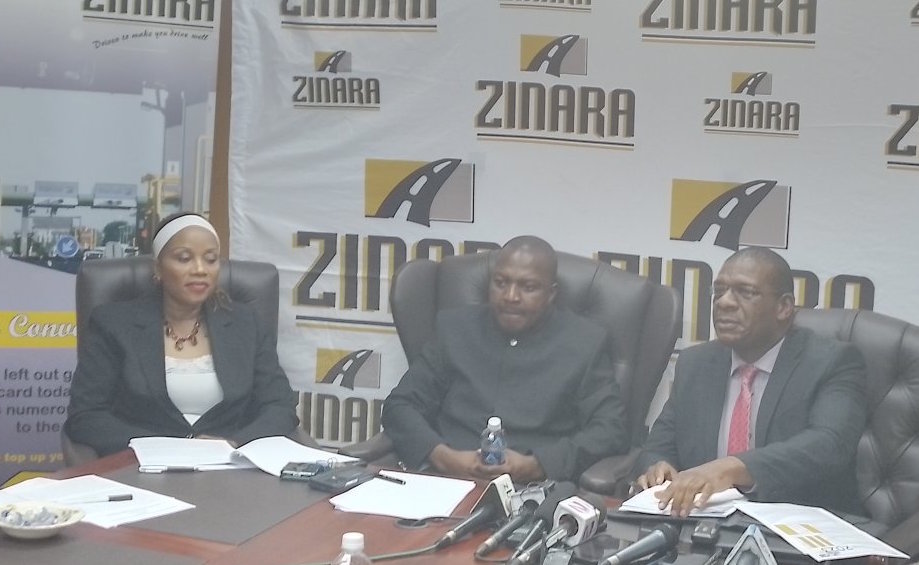|
Getting your Trinity Audio player ready...
|
Riding on robust revenue collection, cost management, and debt servicing, the Zimbabwe National Road Administration (ZINARA) has promised to improve the roads in the country.
This emerged at the ZINARA 2023 Business Overview and Disbursements Report Press Conference held on 28 February 2024 in Harare.
“As the Zimbabwe National Road Administration, we value transparency and accountability and have placed these virtues at the centre of our operations. In 2022, we resolved to publish all disbursements to road authorities as a way of acquitting ZINARA on the utilisation of the road funds that it handles. This was in addition to the other many initiatives by the organisation aimed at resolving legacy governance issues that had historically brought ZINARA into disrepute.
“Some of these key actions include the complete resolution of 59 out of the 63 matters listed in the Grant Thornton forensic audit report and regularisation of the holding of AGMs with Audited Accounts from the Auditor General’s office. This was a key corporate governance activity for which ZINARA had since incurred a 3-year backlog. All these efforts have brought ZINARA into good standing as a corporate entity and with key stakeholders,” said Mr. Nkosinathi Ncube, the CEO of ZINARA.
He said ZINARA’s gross road fee collections amounted to ZWL $868 billion in 2023, closing 13% above budget. The revenue mix comprised 38% contribution from all 29 Tolling points nationwide while licensing fees contributed 34% up from 30% in 2022. Licensing revenue grew in the year owing to the various initiatives we have undertaken to improve access to licensing services by setting up licensing systems at Tollgates, Central Vehicle Registry, ZIMARA, and VID. This, complemented by roadside enforcement operations and marketing promotions, has improved licensing gradually and we anticipate continued growth in the current year. Fuel levies and transit fees contributed 15% and 11% respectively. Overall, traffic volumes through the main revenue streams grew by an average of 7% against the prior year.
The CEO of ZINARA said a great improvement in the uptake of allocation of funds was noted across the provinces as over twenty road authorities claimed 100% of their allocated funds, while a considerable handful still accessed below 75%. The provinces with the highest uptake were Harare Metropolitan Province and Manicaland, both claiming about 97% of their budgets. The lowest claims were from Bulawayo Metropolitan Province, Masvingo and Matebeleland North Provinces, both accessing less than 65% of their budgets. Urban councils in total claimed a combined 81% of their allocated budgets while Rural councils accessed 71%.
Addressing, the same gathering, ZINARA Board Chairman, Dr. George Munyaradzi Manyaya said the organisation funded the maintenance of high-impact projects in various parts of the country.
He said in 2023, Harare did rehabilitation of 31.6 km, 18.18 km asphalt overlay, 30.89km spot gravelling, 411.78km pothole patching, and in terms of bush clearing, covered 1,962km. Some of the refurbished roads that quickly come to mind in Harare include Masotsha Ndlovu, Alpes Road, Sloane, and Tilco Road in Chitungwiza which all handle high traffic volumes daily. These were undertaken both by the road authorities under the Harare Metropolitan Province as well as the Department of Roads under the Ministry of Transport and Infrastructural Development.
Other projects outside of Harare include the Somgolo Bridge which is 178 metres long that was repaired for US$67,272.00. The completion of this project has enabled improved access to critical services and markets as the bridge connects Tsholotsho and Lupane districts.
Another key project was the rehabilitation of the 10km stretch on the Binga Siakobvu road for US$2,950,815.50. The road connects three provinces namely Matabeleland North, Midlands, and Mashonaland West. Furthermore, the road cuts back the current Harare Binga route by 300 km. In other projects, the Rwenya Bridge was worked on at the value of US$869,000. This bridge connects Manicaland and Mashonaland provinces.
“As we continue to fund these key road projects, I urge our esteemed councils or rather road authorities to uphold the highest standards of quality. The work we deliver must be durable, reflecting the trust and investment of the Zimbabwean people. As you may be aware, the country suffered a significant road infrastructure maintenance gap which, as the new ZINARA, we are working flat out to ensure that we recover from in the not-so-distant future. We are, therefore, cognisant that the money that we collect and disburse for the core purposes of road maintenance may not be adequate for the job at hand.
“However, we are confident that if optimally utilised to implement high quality road works, the available funds will steadily influence the gradual and sustainable transformation of our road infrastructure. Our roads are the backbone of our economy, and as such, they should be built to last, accommodating the traffic volumes of both today and tomorrow,” Dr. Manyaya added.






